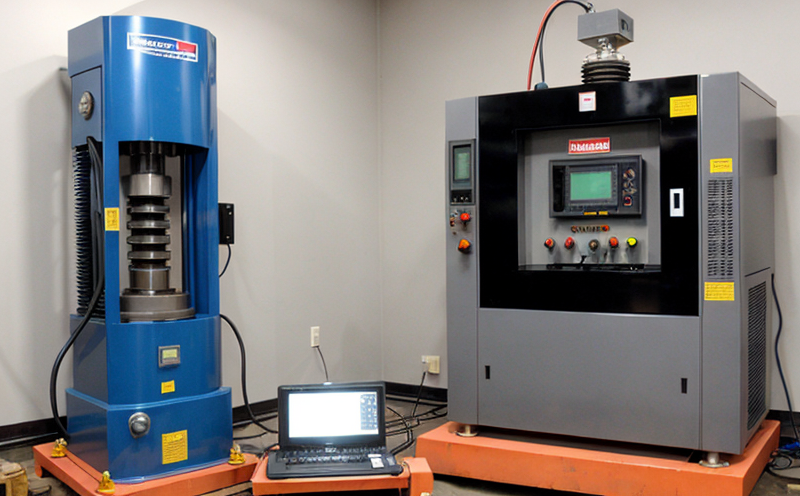EN 50155 Vibration and Shock Testing for Railway Electronics
The European standard EN 50155 is a cornerstone in ensuring the robustness of electronics used in railway applications. This standard specifically addresses environmental stresses, particularly focusing on vibration and shock testing to ensure that electronic components can withstand the harsh conditions encountered during railway operations.
Electronics within the railway sector operate in environments subject to significant mechanical stress due to the dynamic nature of rail travel. Vibration and shock are critical factors that can affect the performance, reliability, and lifespan of electronics. Ensuring compliance with EN 50155 is essential for manufacturers aiming to meet regulatory requirements and ensure product longevity.
During vibration testing per EN 50155, specimens undergo controlled oscillations designed to mimic real-world conditions such as those experienced during train acceleration, deceleration, and braking. These tests are conducted in a frequency range typically between 5 Hz and 300 Hz. Shock testing follows similar principles but with greater force impulses intended to simulate impacts from track irregularities or external events.
Compliance with EN 50155 requires meticulous preparation of the test specimens, including securing them appropriately within the test fixture to avoid any undue stress during the procedures. The tests are conducted in controlled laboratory environments that can replicate real-world conditions accurately. This includes maintaining precise temperature and humidity levels, which may vary depending on the specific requirements outlined in EN 50155.
The testing process involves subjecting the specimens to specified acceleration levels for a defined duration. The standard provides detailed specifications regarding the frequency content and waveform shape of these stimuli. Compliance with these parameters ensures that the tested products are capable of performing reliably under expected operational conditions.
Accurate data recording is crucial during EN 50155 testing, as it allows for thorough analysis and comparison against predefined acceptance criteria. Post-testing evaluation involves inspecting the specimens for any signs of damage or degradation in performance. Any deviation from acceptable limits may indicate potential issues that could affect product reliability.
Compliance with EN 50155 is not merely about meeting regulatory requirements; it underscores a commitment to quality and safety within the railway sector. By adhering strictly to this standard, manufacturers enhance trust among stakeholders by demonstrating their products' resilience against environmental challenges.
| Parameter | Description |
|---|---|
| Vibration Frequency Range | 5 Hz – 300 Hz |
| Shock Impulse Levels | Defined by ISO/IEC standards for railway applications. |
| Environmental Conditions | Controlled temperature and humidity levels as specified in EN 50155. |
| Data Recording | Continuous monitoring of specimen performance during tests. |
In conclusion, compliance with EN 50155 for vibration and shock testing is imperative for ensuring the reliability and longevity of electronics used in railway applications. By adhering to this standard, manufacturers demonstrate their commitment to quality and safety, thereby building trust among stakeholders.
Scope and Methodology
- Vibration Testing: Specimens are subjected to controlled oscillations within a specified frequency range (5 Hz – 300 Hz).
- Shock Testing: Impulse forces are applied to simulate real-world impacts, adhering to ISO/IEC standards.
The testing process is conducted in controlled laboratory environments that can replicate real-world conditions accurately. This includes maintaining precise temperature and humidity levels as specified by EN 50155. Data recording during the tests allows for thorough analysis and comparison against predefined acceptance criteria, ensuring accurate evaluation of specimen performance.
Quality and Reliability Assurance
Ensuring quality and reliability in railway electronics is paramount given their critical role in maintaining safe and efficient rail operations. Compliance with EN 50155 plays a vital role in this regard by providing stringent testing protocols that simulate the environmental stresses encountered during railway travel.
- Data Collection: Continuous monitoring of specimen performance ensures accurate recording of test results.
- Evaluation Criteria: Rigorous inspection post-testing to detect any signs of damage or degradation in performance.
By adhering strictly to these protocols, manufacturers can have confidence that their products will perform reliably under expected operational conditions. This commitment translates into enhanced trust among stakeholders and improved overall system reliability within the railway sector.
Competitive Advantage and Market Impact
- Enhanced Product Reliability: Compliance with EN 50155 ensures that products can withstand environmental stresses, thereby enhancing their overall reliability.
- Market Trust: Adherence to this standard builds trust among stakeholders, translating into a competitive advantage in the market.
The railway sector is highly regulated, and compliance with international standards like EN 50155 sets a benchmark for quality and safety. This not only meets regulatory requirements but also positions companies ahead of competitors by demonstrating their products' robustness against environmental challenges.





